Do you know that the global AI agent market is expected to reach USD 220.9 billion by 2035?
Yes, it's true.
The rise of AI agents is shaping exactly that future, and the numbers back it up. According to recent AI agent market stats, this emerging sector is expanding at a remarkable pace, capturing the attention of entrepreneurs and investors worldwide.
But here’s the key question: What do the latest AI agent market stats tell us about the opportunities ahead?
The answer is clear: they highlight massive growth potential across industries like healthcare, finance, retail, and education.
Entrepreneurs can use these insights to identify where AI agents can streamline operations and unlock new revenue streams. For investors, the data signals a fast-maturing market with high ROI possibilities.
Understanding these statistics is not just about knowing numbers; it’s about spotting the next big wave of innovation and acting early to gain a competitive edge.
Let’s walk you through the given insights related to the global artificial intelligence agent market view, region-wise AI agent market stats, demographic use of AI agents, and much more.
Are you ready to begin?
Yes, then let’s learn them together.
Key Highlights of AI Agent Market Statistics
-
The AI agent market is projected to surpass USD 50.31 billion by 2030, creating high-value opportunities for businesses and investors.
-
Similarly, the global AI agent market size is valued at USD 5.43 billion in 2024, projected to grow from USD 7.92 billion in 2025 to approximately USD 236.03 billion by 2034.
-
Based on the regional market stats of AI agents, the United States, projected to have a revenue of USD $13,459.3 million by 2030, and is expected to gain a CAGR of 43.3% from 2025 to 2030.
-
AI agents solve inefficiency problems by automating decision-making, boosting accuracy, and reducing costs across healthcare, finance, retail, and manufacturing sectors.
-
Entrepreneurs should leverage AI agent market stats to spot profitable industries and design AI-driven solutions that deliver measurable ROI and competitive advantage.
-
Investors gain long-term value as AI agents reshape industries, offering scalable solutions, recurring revenue, and strong adoption across global markets.
-
The AI agent market is scaling fast, and JPLoft helps businesses turn this growth into real ROI with intelligent, future-ready solutions.
Global AI Agent Market View
The artificial intelligence agent market statistics can be effective in identifying what the current trend is and how it can be effective in engaging the audience.
With the global AI agent market view, you will be helpful in learning the complete market.
Let’s evaluate the global AI agent market view in the given stats.
-
The AI agent market size was valued at USD 5.25 billion in 2024, which is projected to grow from USD 7.84 billion in 2025 to USD 52.62 billion by 2030 at a CAGR of 46.3%, during the forecasted period.
-
Additionally, as per Grandview Research, the global AI agents market size was estimated at USD 5.40 billion in 2024, which is projected to reach USD 50.31 billion by 2030, growing at a CAGR of 45.8% from 2025 to 2030.
-
The global AI agent market is expected to rise from USD 9.8 billion in 2025 to USD 220.9 billion by 2035, representing a higher CAGR of 36.55%.
-
As per Yahoo Finance, the global AI agents market size was valued at USD 5.43 billion in 2024, projected to grow from USD 7.92 billion in 2025 to approximately USD 236.03 billion by 2034.
-
The global AI agent market size is expected to reach USD 50.31 billion by 2030, registering a CAGR of 45.8% from 2025 to 2030, according to a new report by Grand View Research.
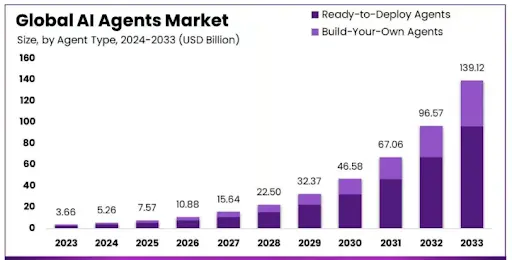
-
As per the Market. Us report, the global AI agent market size is expected to be worth around USD 139.12 billion by 2033, from USD 3.66 billion in 2023, growing at a CAGR of 43.88%.
-
The global AI Agent market is projected to witness a CAGR of 30.23% during the forecast period 2025- 2032, growing from USD 5.31 billion in 2024 to USD 43.93 billion in 2032.
-
Based on Global Market Insight, the overall AI agents market size was estimated at USD 5.9 billion in 2024, and this market is projected to grow from USD 7.7 billion in 2025 to USD 105.6 billion in 2034, at a CAGR of 38.5%.
-
Here, the AI agent market size was valued at USD 3.84 billion in 2024, and is projected to reach USD 51.58 billion by 2032, growing at a CAGR of 38.5% from 2025 to 2032.
-
The Complete AI agent market is projected to grow from USD 5.40 billion in 2024 at a CAGR of 45.8% from 2025 to 2030, which is driven by automation demand and advancements.
Following these stats, let’s proceed with the region-wise AI agent market stats to evaluate the region-wise AI agent parameters in the following section.
Region-Wise AI Agent Market Stats
Learning about the region-wise AI agent market stats will help you analyze the use of AI agents in the specific regions. And as an investor, it will provide you with an idea related to how AI agents are leading the competitive market.
Let’s check out the region-wise AI agent market stats below.
1. Aisa Pacific
-
The AI agents market in Asia Pacific is expected to reach a projected revenue of US $14,154.8 million by 2030, at a CAGR of 49.5% is expected of Aisa Pacific AI agents market from 2025 to 2030.
-
The Asia Pacific is expected to expand at the fastest CAGR during the forecast period.
2. European AI Agent Market
-
The overall European AI agents market was valued at USD 1.32 billion in 2024 and is estimated to reach USD 11.49 billion by 2030, registering a CAGR of 44.1% from 2025 to 2030.
-
Additionally, the European enterprise agentic AI market generated a revenue of USD 634.1 million in 2024. This market is expected to grow at a CAGR of 44.5% from 2025 to 2030.
3. United States Market
-
The AI agents market in the United States is expected to reach a projected revenue of US $13,459.3 million by 2030. Additionally, it is expected to gain a CAGR of 43.3% from 2025 to 2030.
-
Along with this, in terms of revenue, the U.S accounted for 29.7% of the global AI agents market in 2024.
-
The North America AI agents market was estimated at USD 5.40 billion in 2024, and is projected to reach USD 50.31 billion by 2030, growing at a CAGR of 45.8% from 2025 to 2030.
Considering these stats, let's get ahead with the demographics of the AI agent market. With these stats, you will be able to evaluate what the current users are doing and how they are effectively using the AI agent.
Let’s get ahead with the section below.
Demographic Usage of AI Agents
The demographic usage of AI agents can be classified into the given groups. Let’s learn them all below.
-
As per the Pew research, it has been found that 55% of Americans report regularly using AI, and 44% said that they are not regular users.
-
27% of Americans report that they interact with AI several times per day and even more.
-
Along with this, the number of AI users worldwide is estimated to reach 729.11 million by 2030.
-
AI Agents market statistics describe that 80% of Americans reported using four or more common AI tools every week.
-
Based on the AI agent market statistics, 84% of business leaders recognize the potential for artificial intelligence (AI) to disrupt traditional ways of working, where it requires less human oversight and creates more efficient processes.
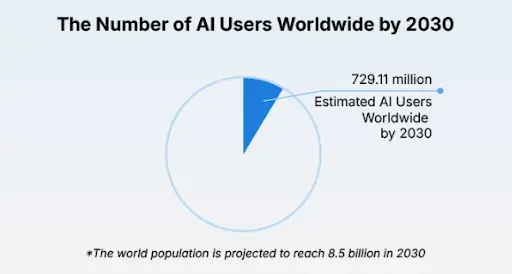
Additionally, as per the above graph, there will be 729.11 million estimated AI users worldwide by the year 2030.
-
Based on the report by Reuters, nearly 90% of the video game developers use AI agents.
-
When we consider the survey of AI agents, 84% of business leaders recognize the potential for artificial intelligence to disrupt the traditional ways of working, where it requires less human oversight and creates more efficient processes.
Following the AI agents' demographics, let’s proceed with how top industries use AI agents in the sector, often in collaboration with mobile app development companies.
How are Different Sectors and Industries Using AI agents? Case Studies
When evaluating how to create an AI agent, it is essential to be aware of the diverse sectors that utilize them.
Let’s learn them all, below.
1. Financial Sector
The global AI agents' financial service market size was USD 490.2 million in 2024, which is projected to reach USD 4,485.5 million by 2030, that is growing at a CAGR of 45.4% from 2025 to 2030.
Additionally, the AI agents are rapidly transforming the financial services through automating the complicated processes, growing at a CAGR of 45.4% from 2025 to 2030.
The AI agents benefit the financial sector by enhancing financial efficiency, strengthening security, improving customer service, and more, making them a vital tool for any fintech app development company aiming to innovate.
2. Education Sector
The global AI in education market size was estimated at USD 2.21 billion in 2024, and is further projected to reach USD 5.82 billion in 2030, that is growing at a CAGR of 17.5% from 2024 to 2030.
Based on the artificial intelligence agent market stats by Grand View Research, the global AI in education market is estimated at USD 5.88 billion in 2024, which is projected to reach USD 32.27 billion in 2030, growing at a CAGR of 31.2% from 2025 to 2030.
Along with this, AI agents in education do provide personalized learning experiences, automating the administrative tasks for educators and offering data-driven insights for institutions.
For investors, AI agents in education signal strong growth potential by driving efficiency and personalization, making partnerships with an educational app development company a smart entry point into this market.
3. Healthcare Sector
Based on the AI agent market statistics, these agents are starting to play a transformative role in healthcare, and their impact spans from the front-line patient care to the deep research labs.
The AI in healthcare market is valued at USD 20.9 billion in 2024, and is further estimated to reach USD 148.4 billion by 2029, registering at a CAGR of 48.1% during the forecast period.
Additionally, these agents play a complete role by enhancing clinical diagnostics and personalizing patient care to improve administrative efficiency and accelerate medical research, making it attractive for investors to collaborate with a healthcare app development company driving this innovation.
4. Gaming and Entertainment
AI agents in fantasy sports or in the entertainment industry are enhancing the overall experience of the users. These agents play an important role in creating dynamic, responsive, and personalized experiences via intelligent non-player characters, adaptive gameplay, and automated testing.
Additionally, AI agents in gaming enhance VR and AR gaming by improving motion tracking, object interactions, and real-time simulations. Here, you can note that the AI-integrated blockchain gaming will be a $50 billion industry by 2030.
The perplexity in fantasy sports apps does elevate the complete user experience with AI. Along with this, it helps to reduce a user’s uncertainty and further improves the overall decision-making procedure.
5. AI in IT and App Development
AI agents in app development streamline and automate various stages of the development process. Moreover, by partnering with a leading AI app development company, you can integrate advanced, intelligent features that accelerate innovation.
The global AI apps market was estimated at USD 2,940 million in 2024, and is further projected to reach USD 26,362.4 million by 2030, at a CAGR of 38.7%. Furthermore, the AI app sector will surpass $150 billion in revenue by the end of the decade.
The AI app sector reached $4.5 billion in revenue in 2024 and is expected to reach $156.9 billion by 2030.
Well, following these stats and numbers, let’s get ahead with a short table stating the same.
|
Sector |
How AI Agents Are Used |
|
Healthcare |
Patient triage, diagnostics, medical imaging analysis, drug discovery, hospital workflow optimization |
|
Finance & Banking |
Fraud detection, robo-advisors, algorithmic trading, claims processing, compliance monitoring |
|
Retail & E-Commerce |
Personal shopping assistants, dynamic pricing, inventory management, conversational commerce |
|
Manufacturing |
Predictive maintenance, quality inspection, supply chain coordination, production scheduling |
|
Logistics & Transportation |
Route optimization, warehouse automation, demand forecasting, fleet management |
|
Education |
Intelligent tutoring, personalized learning paths, grading assistance, st udent performance prediction |
|
Customer Service |
Conversational agents for support, ticket resolution, sentiment analysis, escalation management |
|
Energy & Utilities |
Smart grid optimization, demand–supply balancing, predictive maintenance of infrastructure |
|
Agriculture |
Crop monitoring via drones/sensors, irrigation control, yield forecasting, pest detection |
|
Government & Public Sector |
Citizen service chatbots, fraud detection, resource allocation, and emergency response |
Following the above stats, let’s get ahead with the AI agent market by the technology stack.
AI Agents: Types, Industry Applications, and Market Insights
When you have an AI agent app idea and want to convert it into reality, it becomes essential to look forward to the technology stack. This can help you identify the key aspects related to the top technology stack, as it will help you identify which AI agent to invest in 2025.
Here, is the list of the AI agents that are being used in the industries via the technology stack.
1] Conversational AI Agents (Chatbots & Virtual Assistants)
Conversational AI agents are smarter systems that are capable of engaging with humans using natural language, in the form of text, voice, or even multimodal input.
They are built to comprehend intent, process info, and respond contextually, and typically perform actions such as answering questions, giving suggestions, or executing actions. The overall conversational AI agents market size was estimated at USD 11.58 billion in 2024, which is estimated to reach USD 41.39 billion by 2030.
Here is the table defining how conversational AI agents are being used in different sectors.
|
Role of Conversational AI Agents |
Market Size Insight |
|
Customer Service & Support – Automating FAQs, order tracking, returns, and complaint resolution |
The conversational AI market size was USD 11.58B in 2024, projected to reach USD 41.39B by 2030. |
|
Banking & Finance – Fraud alerts, 24/7 account services, personalized financial advice |
Market projected at USD 17.05B in 2025, growing to USD 49.80B by 2031 (CAGR ~19.6%) |
|
Healthcare – Symptom checking, appointment scheduling, patient engagement agents |
Global conversational AI market forecast USD 13.6B in 2024 → USD 151.6B by 2033 (CAGR ~29.16%) |
|
Education – Intelligent tutoring, student Q&A bots, grading assistants |
Chatbot market value projected at USD 15.57B by 2025 |
|
Retail & E-Commerce – Conversational shopping, product recommendations, personalized promotions |
Chatbot market estimated at USD 15.6B in 2024, expected to hit USD 46.6B by 2029. |
|
Hospitality & Travel – Virtual booking assistants, check-in support, itinerary help |
The conversational AI (chatbots) already handles over 75% of customer inquiries within the hospitality settings. |
|
Enterprise IT & HR – Onboarding support, HR helpdesk, IT troubleshooting agents |
The global HR conversational AI agent market is expected to achieve USD 1811.7 million by 2033. Expected to grow at a CAGR of 9.28% |
2] Predictive & Analytics-Driven AI Agents
Now, let’s get ahead with the predictive and analytics-driven AI agents. These agents mainly focused on analyzing massive datasets, spotting patterns, and forecasting outcomes. Along with this, they are used in industries such as finance for fraud detection, in retail for demand forecasting, and in healthcare for predicting patient risks.
Additionally, the global predictive analytics market size was valued at USD 18.89 billion in 2024, which is projected to reach USD 82.35 billion by 2030.
Let’s look forward to the table below.
|
Role / Use of Predictive & Analytics-Driven AI Agents |
Market Size / Stats |
|
Healthcare – Predict disease outbreaks, forecast patient readmissions, optimize treatment plans |
AI in healthcare analytics market projected to reach USD 80.2B by 2030 |
|
Retail & E-commerce – Personalized recommendations, demand forecasting, customer behavior prediction |
Global predictive analytics in retail is estimated at USD 10.9B by 2030 (Fortune Business Insights) |
|
Supply Chain & Logistics – Route optimization, inventory forecasting, risk analysis |
AI in supply chain market forecast to be USD 45.1B by 2032. |
|
Marketing & Sales – Campaign performance prediction, lead scoring, customer lifetime value forecasting |
Predictive analytics in marketing is expected to exceed USD 18.5B by 2030. |
|
Energy & Utilities – Demand forecasting, smart grid optimization, equipment maintenance |
AI in energy analytics market size projected to cross USD 14.5B by 2032 (GlobeNewswire) |
3] Autonomous Decision-Making Agents
The autonomous decision-making agents are the AI systems that are designed to act without any constant human oversight. These agents do analyze the data, weigh options, and execute decisions in real-time across industries such as healthcare, finance, manufacturing, and logistics.
Furthermore, when it comes to analyzing the market size of autonomous AI agents, it is projected to reach USD 70.53 billion by 2030, growing at a CAGR of 42.8% from 2023 to 2030.
Let’s learn it all in the following table in brief.
|
Role / Application |
Market / Stat |
|
Healthcare / Clinical Decision Support – recommending treatments, triaging, alerting on risks |
Clinical decision support systems market estimated at USD 5.79B in 2024, reaching USD 10.71B by 2030. |
|
Supply Chain / Logistics / Autonomous Routing – route selection, demand forecasting, inventory decisions |
AI in logistics & supply chain market valued ~USD 20.1B in 2024, projected growth at CAGR ~25.9%. |
|
General / Cross-domain Autonomous AI – fully autonomous agentic systems making decisions in varied environments |
Autonomous AI market projected to grow from USD 6.86B in 2024 to USD 170.6B by 2034. |
4] Multi-Agent Systems (Collaborative AI Agents)
The multi-agent systems (MAS) are the networks of multiple autonomous agents that interact or compete to achieve goals. Here, each agent can make decisions independently, but together they coordinate to solve the complex problems that a single system can’t handle efficiently.
When it comes to learning about the stats, the global multi-agent system market is projected to reach about USD 6.3 billion in 2025, growing to USD 184.8 billion by 2034.
Let’s consider the following table in brief to learn about the role of multi-agent systems and related stats.
|
Role of Multi-Agent Systems |
Market Size / Stats |
|
Smart Grids & Energy – agents balance power loads, forecast demand, and manage renewable integration |
Multi-agent smart grid applications are part of AI in the energy market, projected to reach USD 14.5B by 2032 |
|
Transportation & Traffic Control – agents optimize traffic signals, coordinate autonomous vehicles, and reduce congestion |
Intelligent transportation systems market expected to hit USD 74.7B by 2030 |
|
Robotics & Manufacturing – multi-robot coordination for assembly lines, warehouse automation, and swarm robotics |
Robotics market projected at USD 283.2B by 2032 (multi-agent robots are a subset) |
|
Healthcare & Research – agents collaborate in medical diagnosis, drug discovery, and hospital operations |
AI in the healthcare market is expected to reach USD 148.4B by 2032 |
|
Supply Chain & Logistics – agents manage routing, inventory, and demand-supply disruptions across networks |
AI in the logistics market is projected at USD 45.1B by 2032 |
5] Cognitive AI Agents (NLP, Vision, and Speech Capabilities)
Cognitive AI agents are advanced systems that are designed to mimic human cognitive functions such as perception, reasoning, natural language understanding, and learning.
Unlike basic rule-based bots, they can process unstructured data (speech, images, text), understand context, and make adaptive decisions.
These agents are widely used in sectors requiring human-like interaction, such as healthcare diagnostics, customer service, and education. The cognitive AI market is projected to grow from about USD 33.78 billion in 2025 to USD 110.45 billion by 2030.
|
Role of Cognitive AI Agents |
Market Stats & Sources |
|
Healthcare – Medical imaging analysis, clinical decision support, patient communication |
Cognitive computing in healthcare is projected to reach USD 14.7B by 2030. |
|
Customer Service & CX – Natural language chatbots, voice assistants, sentiment analysis |
Cognitive computing market size valued at USD 25.6B in 2023, forecasted to hit USD 264.2B by 2033 |
|
Education – Personalized tutoring, adaptive learning systems, language understanding |
AI in education is projected to grow from USD 5.82B in 2024 to USD 32.27B by 2030. |
6] Robotic Process Automation (RPA) Agents with AI Integration
The robotic process automation agents use software “bots” or AI agents to automate repetitive Robotic process automation uses the software bots for automating repetitive rule-based tasks that humans typically perform. Along with this, it further comprises data entry, invoice processing, claims handling, and HR onboarding.
When it comes to evaluating the stats of AI agents, the AI in the RPA market is estimated at USD 3.3 billion in 2023, which is forecasted to reach USD 11.8 billion by 2033.
Let’s learn it all in the following table in brief.
|
Role of RPA in Different Sectors |
Market Size / Stats |
|
Banking & Finance – Automating claims processing, compliance checks, and loan approvals |
RPA in BFSI market projected to reach USD 4.9B by 2027 |
|
Healthcare – Automating patient records, billing, and insurance claims |
Global RPA in healthcare expected to grow at a CAGR 25.9% (2023-2030) |
|
Manufacturing – Streamlining supply chain workflows, procurement, and quality checks |
RPA in manufacturing projected CAGR ~33.2% (2022-2030) |
7] Generative AI-Powered Agents
Generative AI-based agents are self-running programs that employ large language models (LLMs) or generation models to plan, reason, and execute (e.g., through APIs or integrations), not simply react.
In contrast to traditional chatbots, they can decompose tasks, call out external tools or databases, make decisions, sequence actions, and accumulate adaptation over time.
When it comes to analyzing the AI agent market stats, the global generative AI market size was estimated at USD 16,877.1 million in 2024, and is projected to reach USD 109,370.1 million by 2030.
What this truly implies is: rather than "you query, the model responds," these agents actively manage workflows.
Examples: A "research agent" that scours websites for information, aggregates a report, quotes sources, and sends notifications.
A "customer-support agent" that resolves context from previous tickets, the knowledge base, and automatically escalates routes.
A "dev ops agent" that identifies bugs in logs, issues a patch request, and initiates testing pipelines.
Let’s look ahead at the given table for more inputs on the AI agent market uses.
|
Sector / Industry |
Type of Agent Use / Adoption |
Measurable Impact or Market Indicator |
|
Software / Application Market |
AI agents integrated into developer tools, productivity apps |
Goldman Sachs estimates the application software market could grow to USD 780 billion by 2030, with a large share of growth driven by agentic features. |
|
Enterprise / AI Agents Market |
General AI agents (multi-use across industries) |
MarketsandMarkets forecasts AI agents market from USD 5.25 B (2024) to ~USD 52.62 B by 2030. |
|
Gaming / Game Development |
Agents to automate content, environments, and NPC behavior |
87% of video game developers now use AI agents for various creative and automation tasks. |
|
Public Sector / Services |
Agents to automate content generation, document processing, citizen interaction |
In UK public sector, 22% already actively use generative AI systems, 45% aware of such use. |
|
Construction / Design |
Generative agents for querying contracts, design suggestions, and planning |
Use of retrieval-augmented generation (RAG) in construction improves relevance and reproducibility metrics (e.g. 4–9 % boosts) per case studies. |
8] Hybrid AI Agents (Combining Human-in-the-Loop + Automation)
Hybrid AI agents combine autonomous task execution with focused human intervention at critical points of decision. The agent handles data gathering, planning, and mundane tasks; humans review suspicious cases, install safeguards, and determine edge cases.
Executed well, this architecture improves accuracy, safety, and ROI while maintaining model drift, bias, and compliance under control. Imagine it as automation with judgment at their fingertips: the agent escalates the work; humans ensure it's right and on point.
To put this in context, analyst houses anticipate "agentic AI" to reside within more enterprise software applications within the next couple of years, migrating a portion of daily decisions to software agents, though with governance and human oversight still being integral.
When it comes to evaluating the AI agent market stats, the global hybrid AI market size generated USD 7.9 billion in 2024, and is projected to register a growth from USD 9.9 billion in 2025 to about USD 76.9 billion by 2034. Let’s look forward to the following table for more stats.
|
Sector |
How hybrid agents are used (HITL + automation) |
Impact (numbers) |
|
Customer experience/marketing |
Predictive “next-best experience” engines automate offers and timing; human teams approve treatment libraries, audit fairness, and tune KPIs. |
+15–20% CSAT, +5–8% revenue, −20–30% cost-to-serve observed in deployments. |
|
Telecom/retention ops |
AI flags churn risk and proposes actions; agents review and apply compensations or plan changes on sensitive accounts. |
Up to 20% lower merchant attrition in a payments case; telecom cases show NPS lift to market-leader levels and churn reduction. |
|
Healthcare imaging |
Concurrent AI readers triage and pre-screen; radiologists validate findings and handle edge cases. |
Reading time −27.2%; reading quantity reduced 44–62% depending on workflow, with sensitivity maintained or improved. |
|
Manufacturing/maintenance |
Predictive maintenance agents schedule interventions; technicians confirm work orders and exceptions. |
Downtime −30–50%; maintenance costs −10–40%; equipment life +20–40%. |
|
Retail/airlines (personalization & service recovery) |
AI ranks treatments; human advisors approve customer-sensitive steps and finalize outreach. |
In one airline case: +210% targeting accuracy, +800% CSAT on targeted cohort, −59% churn intent; broader programs show +5% incremental revenue and ~4× ROI in pilots. |
Future Trends of the AI Agent Market Statistics
The AI Agent trends do comprise agentic autonomy for independent decision-making, multi-agent collaboration for complex tasks, and enhanced memory, as well as personalization for tailored experiences.
Let’s evaluate the future trends in the given stats.
1. Rise of Self-Sufficient Decision-Making Agents
AI agents are breaking free from mere automation into autonomous decision-making. Over 50 percent of organizations now see agentic AI as a priority area. Amazon Web Services, Inc.
They’ll increasingly evaluate situations, balance trade-offs, and make real-time decisions in finance, healthcare, and logistics, minimizing human intervention in mission-critical workflows.
2. Hybrid Models with Human-in-the-Loop
The future is not completely autonomous; it’s hybrid. The global hybrid intelligence market was valued at around USD 16.3 billion in 2024 and is projected to reach USD 52.6 billion by 2030, growing at a CAGR of 21.6 %.
Under this model, agents may perform 80–90 % of tasks automatically, with human intervention reserved for exceptions, compliance checks, or ethical concerns. That balance provides trust while preserving scale.
3. Sector-Specific Agent Ecosystems
Rather than one-size-fits-all technologies, industries will see customized AI agents, wealth-management advisors in finance, clinical copilots in medicine, and AI-powered CX reps in retail. These domain-specific systems accelerate adoption and produce measurable ROI faster.
4. Integration with Multimodal AI
AI agents will begin to integrate text, voice, image, and video inputs to handle more complex tasks. Imagine an agent reading medical scans, viewing lab notes, and conversing with physicians, all in one sequence.
5. Agent-Orchestrated Workflows Across Platforms
Enterprises will use swarms of AI agents that communicate and coordinate tasks, like scheduling, reporting, and forecasting, across CRM, ERP, and HR systems. This orchestration trend will redefine enterprise productivity models.
6. Accents on Governance, Regulation, and Trust
As adoption grows, regulators will demand audit trails, bias testing, and compliance logs in agent systems.
In fact, according to PwC, 79 percent of executives say AI agents are already being adopted by their companies, and 66 percent of those report measurable value like productivity increases. PwC's Future expansion will depend not only on capability but on building trustworthy, explainable agents that align with global standards.
Following these future trends, you can include the effective AI agent features that will help you to engage potential users and lead the competitive market.
Partner With JPLoft and Create your Own AI Agent
If you’re looking to bring the power of intelligent automation into your business, JPLoft is the partner you need. As a trusted AI agent development company, we specialize in building custom AI agents that go beyond basic automation to deliver real decision-making capabilities.
Our team blends technical expertise with industry insights, ensuring your AI agent is designed to meet the unique demands of your sector, whether it’s finance, healthcare, retail, or logistics.
At JPLoft, we don’t just develop; we co-create with you. From strategy and design to deployment and scaling, our professionals work closely to align every step with your business goals.
The result is an AI agent that improves efficiency, reduces costs, and positions you at the forefront of innovation. Partner with JPLoft today and lead your market with smart, future-ready AI solutions built to perform.
Conclusion
The AI agent market is witnessing rapid growth, fueled by automation demand, advanced analytics, and sector-specific adoption. With projections showing the market surpassing USD 50 billion by 2030, businesses and investors alike are seeing unprecedented opportunities. From healthcare diagnostics to financial automation and retail personalization, AI agents are proving their value across industries.
The future points toward hybrid models, multimodal capabilities, and stronger regulatory frameworks. Those who act now can not only benefit from cost reductions and productivity gains but also secure a strategic advantage in shaping how industries operate in the next decade.
FAQs
The AI agent market is projected to reach around USD 50.31 billion by 2030, growing at a CAGR above 45%. This rapid growth reflects strong adoption across multiple industries.
Asia Pacific is the fastest-growing region, expected to expand at a CAGR of 49.5%. Strong demand in China, India, and Japan is driving innovation and large-scale deployment.
In finance, AI agents streamline fraud detection, claims processing, and algorithmic trading. They also enhance customer experiences by offering personalized advisory services and 24/7 support.
Industries like healthcare, finance, retail, IT, manufacturing, and education are seeing major gains. Use cases range from patient diagnostics and robo-advisors to predictive maintenance and intelligent tutoring systems.
Investors should consider AI agents because they combine high growth potential with proven ROI. They reduce operational costs, improve scalability, and open new revenue streams across multiple verticals.
Future trends include autonomous decision-making agents, hybrid human-in-the-loop systems, multimodal AI, sector-specific agent ecosystems, and increased focus on regulation and governance.





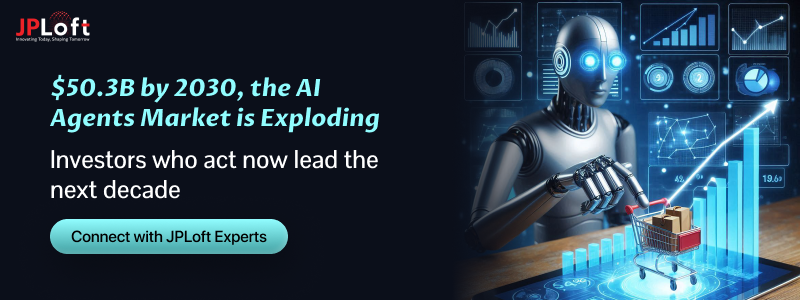
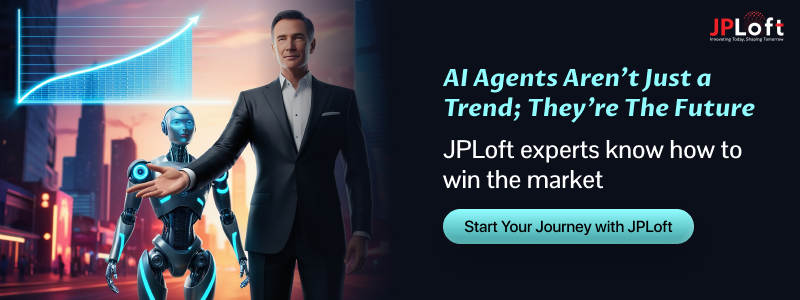


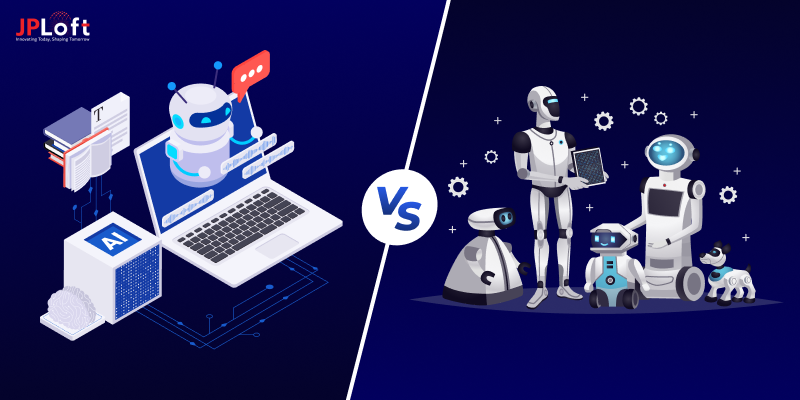



Share this blog